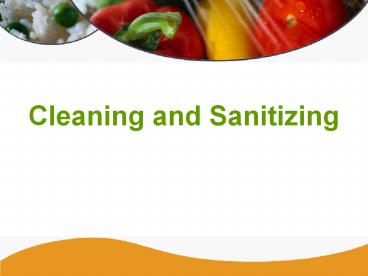Cleaning and Sanitizing - PowerPoint PPT Presentation
Title:
Cleaning and Sanitizing
Description:
A test kit that accurately measures the concentration of sanitizing solutions must be available. ... Storing Cleaned and Sanitized Items. In clean, dry location ... – PowerPoint PPT presentation
Number of Views:13602
Avg rating:3.0/5.0
Title: Cleaning and Sanitizing
1
Cleaning and Sanitizing
2
Cleaning
- Cleaning is the process of removing food and
other soils. - Cleaning Agents
- Detergents
- Solvent cleaners
- Acid cleaners
- Abrasive cleaners
3
Sanitizing
- Sanitizing is the process of reducing the number
of microorganisms that are on a properly cleaned
surface to a safe level. - A safe level is 99.999 reduction of the number
of disease microorganisms that are of public
health importance. - Sanitizing agents only work on properly cleaned
and rinsed surfaces.
4
Methods for Sanitizing
- Heat
- Hot water 170oF or 180oF
- Steam
- Chemicals
- Chlorine 50 ppm
- Quaternary Ammonia 200 ppm
- Iodine 12.5 ppm
5
Activity
- Sanitizing Preparation
6
Dish machines
- High temperature machines
- Final sanitizing rinse must be 180oF (82oC) or
hotter - Measure water temperature at the manifold
- Chemical sanitizing machines
- Wash water 120oF (49oC) or hotter
- Rinse water 75oF (24oC) to 120oF (49oC)
- Use the recommended sanitizer
- Follow the manufacturers instructions
7
Three-compartment sink
- 1. Wash -- Water temperature at least 110oF
(43oC) - 2. Rinse -- Water temperature at least
110oF(43oC) - 3. Sanitize -- Hot water temperature of 171oF
(77oC) to 180oF (82oC) or chemical solution of 50
ppm - 4. Air-dry -- Do not hand dry
Never mix chemical sanitizers with washing water
detergents
8
Measuring Sanitizer Strength
- A test kit that accurately measures the
concentration of sanitizing solutions must be
available. - The strength of sanitizing solutions must be
measured frequently during use.
9
Food-Contact Surface
- A food-contact surface is
- a surface that food normally touches or
- a surface where food might drain, drip, or splash
into a food or onto a surface that normally
touches food - Examples
- Utensils, cutting boards, slicers, countertops,
storage bins, baking sheets, refrigerator shelves
10
Cleaning Food-Contact Surfaces
- Immersion
- Wash with detergent
- Rinse thoroughly
- Immerse in a properly prepared sanitizing
solution. - In-place sanitizing
- Spray solution
11
Cleaning Non-Food Contact Surfaces
- Non-food contact surfaces
- exterior of refrigerator, stovetops, and
refrigerator gaskets. - Wash with detergent and rinse but do not need to
sanitize. - Keep free of dirt, dust, and debris.
12
Activity
- Food-contact Surface or Not?
13
Food-contact Surface or Not?
14
Food-contact Surface or Not?
15
Food-contact Surface or Not?
16
Food-contact Surface or Not?
17
Storing Cleaned and Sanitized Items
- In clean, dry location
- Not exposed to splash, dust, or other
contamination - At least 6 inches (15 cm) above the floor
- In a self-draining position
- Covered or inverted
18
Chemicals
- Improperly stored chemicals can possibly
contaminate food. - Store separate from food, equipment, utensils,
linen, and single-service and single-use items. - If removed from their original package, label the
container in which they are stored.
19
Material Safety Data Sheets
- OSHA requires a Material Safety Data Sheet (MSDS)
for all chemicals. - On every MSDS, be familiar with the following
sections - 4.0 Fire and explosion data
- 5.0 Reactivity data
- 6.0 Spill or leak procedures
- 7.0 Health hazard data
- 8.0 First aid
- 9.0 Protective measures
- 10.0 Additional information/precautions
20
Material Safety Data Sheet

